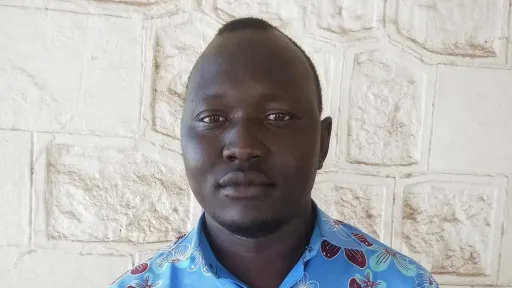By Paula Odek
Joe Mudukiza knows all too well the daily struggles of living with sickle cell disease. He was six months old when diagnosed with this chronically debilitating, and often life-threatening genetic condition that afflicts 300,000 children worldwide every year.
Like Joe, who is now 28, more than 75% of these children live in sub-Saharan Africa, according to a report in The Lancet.
Sickle cell disease is an autosomal recessive genetic blood disorder characterised by abnormal haemoglobin that distorts the shape of red blood cells, making it difficult for them to pass through blood vessels smoothly.
For Joe, handling the episodes of excruciating pain that come with sickle cell disease is a constant battle, overshadowing every aspect of his life.
It is a hidden war that Joe fights, appearing healthy on the outside while battling a rare, life-threatening disease internally. This insidious struggle leaves him physically and emotionally drained.
"I have been taking medication my entire life," Joe tells TRT Afrika, giving voice to an anguish those with the condition harbour.
Mockery
It wasn't until he turned 14 that Joe's school nurse asked his mother to explain the reason behind his medication. At the age of 15, he finally comprehended the true nature of his condition, and why he was different from other children.
Joe fondly remembers how his mother would give him endearing nicknames like "Superman" when it was time to take his medicines, attempting to alleviate the burden of his treatment. But the challenges extended beyond medication.
The isolation and stigma worsened Joe's struggles, making him feel like an outsider among others of his age. His classmates would mock him for his petite frame, taunting him with remarks like, "Can you put a few stones so you won't be blown away by the wind?"
'Tearing off skin'
Sickle cell disease inflicts unimaginable pain on the body, leaving its victims physically and emotionally drained. Joe describes the pain as an unrelenting assault, likening it to someone "tearing off my skin and pouring broken glass into my veins".
The constant pain poses significant challenges and severely limits Joe's ability to lead a normal life. "Painful episodes occur specifically in my arms, legs, and joints. As I grew older, the pain became more frequent, spreading throughout my body," he explains.
While his friends from college are building careers, getting married, and starting families, Joe finds himself confined to a cancer ward, fighting for his life.
The association of sickle cell disease with the cancer ward serves as a stark reminder of the gravity and complexity of his condition.
This harsh reality has cost him friendships and forced him into a life of solitude, as the financial burden of treatment has made him feel like a burden to others. Joe yearns to lead a life like his peers, free of pity and filled with normalcy.
The constant pain and challenges have taken a toll on his mental health, too, leading to bouts of depression.
There are days when he wishes sickle cell disease would take a vacation, granting him respite from the never-ending battle.
Experts' views
"I wish it would work half shifts and take two weeks off, but no, I am worse than ever," Joe says.
Nevertheless, Joe refuses to succumb to despair. Through his personal experience, he has gained a profound understanding of the impact of sickle cell disease, and the urgent need for awareness.
According to Professor Jessie Githanga, a haematologist specialising in sickle cell disease, this inherited condition is characterised by abnormal red blood cells, leading to a deficiency of blood and frequent pain crises known as vaso-occlusive crises.
As individuals with sickle cell disease grow, they may experience a range of complications that can affect various organs in the body, including the eyes, liver, kidneys, gallbladder, spleen, and other tissues like bones.
Prof Githanga explains that signs of sickle cell disease typically become apparent when a child reaches six months of age. At three months, they may present with infections or anaemia, which is a lack of blood.
Most commonly, at around six months of age, they will start experiencing pain and swelling, especially in the fingers and toes, a condition known as dactylitis. As they grow older, they may develop pain in other parts of the body.
The signs and symptoms of sickle cell disease can vary from person to person and may change over time.
Most of these symptoms are related to complications of the disease and can include fatigue or fussiness from anaemia; a yellowish colour of the skin (jaundice) or in the white of the eyes (icteris); shortness of breath, and extreme fatigue.
Managing pains
To prevent sickle cell disease, Prof Githanga emphasises the importance of genetic testing and counselling to determine carrier status. Through specific blood tests, individuals can identify if they carry the sickle cell gene and receive appropriate genetic counselling.
Early intervention and management are crucial, making newborn-testing particularly important in regions with a high prevalence of sickle cell disease.
Contrary to popular belief, individuals with sickle cell disease can live well beyond the age of 18, dispelling the misconception that their lifespan is significantly limited.
Prof Githanga advocates specialised care for individuals with sickle cell disease, particularly during pregnancy and delivery.
Pregnant women with sickle cell anaemia should seek follow-up care in specialist antenatal clinics staffed by experts well-versed in managing patients with this condition.
When it comes to managing pain crises, simple painkillers like paracetamol are often recommended, while severe pain may require the use of opioids such as morphine or tramadol.
Nutritious meal
Hydroxyurea is considered a standard treatment that helps prevent pain crises. Bone marrow transplant is another method but it is expensive and one’s bone barrow should match the patient.
However, it is essential to note that not all treatments work for every patient, and some options may be expensive and not widely accessible.
In addition to medical interventions, Prof Githanga highlights the importance of maintaining a balanced diet for sickle cell patients.
A well-rounded and nutritious meal plan can help address the deficiencies associated with the disease and support overall health.
























